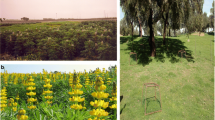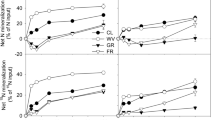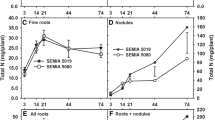Summary
The availability and turnover in different soil fractions of residual N from leguminous plant material and inorganic fertilizer was studied in a pot culture experiment using wheat as a test crop. Plants utilized 64% of the residual fertilizer N and 20% of the residual legume N. 50–60% of the N taken up by plants was recovered in grain and 4–8% in roots. After harvesting wheat up to 35% and 38% of the residual legume N and fertilizer N, respectively was found in humic compounds. A loss of humus N derived from legume and fertilizer was found during wheat growth but the unlabelled N increased in this fraction. Biomass contained 6% and 8% of the residual legume and fertilizer N, respectively when both were available. The mineralizable component contained upto 28% of both the residual legume and residual fertilizer N. Only a small percentage of the soil N (3–4%) was observed in biomass whereas the mineralizable component accounted for 7–14% of the soil N. In this fraction legume derived N increased during wheat growth whereas unlabelled N increased in both the mineralizable component and microbial biomass.
Some loss of N occurred from residual legume and fertilizer N. Nevertheless, a positive total N balance was observed and was attributed to the addition of unlabelled N in the soil-plant system by N2 fixation. The gain in N was equivalent to about 38% of the plant available N in the soil amended with leguminous material. The additional N was concentrated mainly in the mineralizable fraction and microbial biomass, although some addition was also noted in humus fractions.
Similar content being viewed by others
References
Allen A L, Stevenson F J and Kurtz L T 1973 Chemical distribution of residual fertilizer nitrogen in soil as revealed by nitrogen-15 studies. J. Environ. Qual. 2, 120–124.
Azam F, Malik K A and Sajjad M I 1985 Transformation in soil and availability of plants of15N applied as inorganic fertilizer and legume residues. Plant and Soil 86, 3–13.
Boddey R M, Chalk P M, Victoria R and Mitsui E 1983 The15N isotope dilution technique applied to the estimation of biological nitrogen fixation associated withPaspalum notatum cv. batatais in the field. Soil Biol. Biochem. 15, 25–32.
Bremner J M 1965 Total nitrogen.In Methods of Soil Analysis, Part 2, Ed. C A Black, pp 1149–1178, Am. Soc. Agron. Inc, Madison.
Broadbent F E 1980 Residual effects of labelled N in field trials. Agron. J. 72, 325–329.
Dart P J and Subba Rao R V 1981 Nitrogen fixation associated with sorghum and millet.In Associative N2 fixation, Eds. P B Vose and A P Ruschel, pp 169–177, CRC Press Inc. Palm Beach, Florida.
de Frietas J Re, Victoria R L, Ruschel A P and Vose P B 1984 Estimation of N2-fixation by sugarcane,Saccharum sp. and soybeanGlycine max grown in soil with15N labelled organic matter. Plant and soil 82, 257–267.
Dobereiner J and Day J M 1975 Nitrogen fixation in the rhizosphere of grasses.In Nitrogen Fixation by Free-living Microorgansms. Ed W D P Stewart, pp 39–56, Cambridge University Press.
Hauck R D 1971 Quantitative estimates of nitrogen cycle processes-concepts and view.In Nitrogen-15 in Soil Plant Studies, pp 65–90. IAEA, Vienna.
Hacuk R D and Bremner J M 1976 Use of tracers for soil and fertilizer nitrogen research. Adv. Agron. 28, 219–266.
Hussain F and Malik K A 1985 Modification of the acid permanganate method for obtaining an index of soil nitrogen availability. Plant and Soil 84, 143–146.
Hussain F, Malik K A and Azam F 1984 Evaluation of acid permanganate extraction as an index of soil nitrogen availability. Plant and Soil 79, 249–254.
Jansson S L and Person J 1982 Mineralization and immobilization of soil nitrogen.In Nitrogen in Agricultural Soils, Ed. F J Stevenson, pp 229–252. Am. Soc. Agron. Inc. Madison.
Jenkinson D S and Ladd J N 1981 Microbial biomass in soil: Measurement and turnover.In Soil Biochemistry, Vol. 5, Eds. E A Paul and J N Ladd, pp 415–471, Dekker, New York.
Jenkinson D S and Powlson D S 1976 The effects of biocidal treatments on metabolism in soil-1. Fumigation with chloroform. Soil Biol. Biochem. 8, 167–177.
Kundler P 1970 Utilization, fixation and loss of fertilizer nitrogen (review of international results in the last 10 years basic research). Albrecht-Thaer-Arch. 14, 191–210.
Ladd J N, Oades J M and Amato M 1981 Distribution and recovery of nitrogen from legume residues decomposing in soil sown to wheat in the field. Soil Biol. Biochem. 13, 251–256.
Ladd J N, Amato J M, Jackson R B and Butler J H A 1983 Utilization by wheat crops of nitrogen from legume residues decomposing in the field. Soil Biol. Biochem. 15, 231–238.
Legg J O and Meisinger J J 1982 Soil nitrogen budgets.In Nitrogen in Agricultural Soils, Ed. F J Stevenson, pp 503–566, Am. Soc. Agron. Inc., Madison.
Paul E A and Juma N G 1981 Mineralization and immobilization of soil nitrogen by microorganisms.In Terrestrial Nitrogen Cycles: Processes, Ecosystem Strategies and Management Impact, Eds. F E Clark and T Rosswal, pp 179–195, Ecol Bull. 33, Stockholm
Purchase B S 1978 Nitrogen fixation associated with grasses: A potential source of nitrogen for Rhodesian agriculture. Rhodesia Agric. Res. 75, 99–104.
Rudelov Ye V 1982 Dynamics of immobilized nitrogen. Sov. Soil Sci. 14, 40–45.
Smith S J, Chichester F W and Kissel D E 1978 Residual forms of fertilizer nitrogen in field soils. Soil Sci. 125, 165–169.
Stevenson F J 1981 Organic matter and nutrient availability. Trans. 12th Intern. Congr. Soil Sci. (New Delhi), Symp. Papers 1, 137–150.
Stevenson F J 1984 Nitrogen transformations in soil-A perspective.In Nitrogen and the Environment, Eds K A Malik, S H M Naqvi and M I H Aleem. Published by NIAB, Faisalabad, Pakistan.
westerman R L and Kurtz L T 1972 Residual effects of15N labelled fertilizers in a field study. Soil Sci. Soc. Am. Proc. 36, 91–94.
Author information
Authors and Affiliations
Rights and permissions
About this article
Cite this article
Azam, F., Malik, K.A. & Sajjad, M.I. Uptake by wheat plants and turnover within soil fractions of residual N from leguminous plant material and inorganic fertilizer. Plant Soil 95, 97–108 (1986). https://doi.org/10.1007/BF02378856
Received:
Revised:
Issue Date:
DOI: https://doi.org/10.1007/BF02378856




